Exercise training reverses age-induced diastolic dysfunction and restores coronary microvascular function
- PMID: 28295341
- PMCID: PMC5471361
- DOI: 10.1113/JP274172
Exercise training reverses age-induced diastolic dysfunction and restores coronary microvascular function
Abstract
Key points: In a rat model of ageing that is free of atherosclerosis or hypertension, E/A, a diagnostic measure of diastolic filling, decreases, and isovolumic relaxation time increases, indicating that both active and passive ventricular relaxation are impaired with advancing age. Resting coronary blood flow and coronary functional hyperaemia are reduced with age, and endothelium-dependent vasodilatation declines with age in coronary resistance arterioles. Exercise training reverses age-induced declines in diastolic and coronary microvascular function. Thus, microvascular dysfunction and inadequate coronary perfusion are likely mechanisms of diastolic dysfunction in aged rats. Exercise training, initiated at an advanced age, reverses age-related diastolic and microvascular dysfunction; these data suggest that late-life exercise training can be implemented to improve coronary perfusion and diastolic function in the elderly.
Abstract: The risk for diastolic dysfunction increases with advancing age. Regular exercise training ameliorates age-related diastolic dysfunction; however, the underlying mechanisms have not been identified. We investigated whether (1) microvascular dysfunction contributes to the development of age-related diastolic dysfunction, and (2) initiation of late-life exercise training reverses age-related diastolic and microvascular dysfunction. Young and old rats underwent 10 weeks of exercise training or remained as sedentary, cage-controls. Isovolumic relaxation time (IVRT), early diastolic filling (E/A), myocardial performance index (MPI) and aortic stiffness (pulse wave velocity; PWV) were evaluated before and after exercise training or cage confinement. Coronary blood flow and vasodilatory responses of coronary arterioles were evaluated in all groups at the end of training. In aged sedentary rats, compared to young sedentary rats, a 42% increase in IVRT, a 64% decrease in E/A, and increased aortic stiffness (PWV: 6.36 ± 0.47 vs.4.89 ± 0.41, OSED vs. YSED, P < 0.05) was accompanied by impaired coronary blood flow at rest and during exercise. Endothelium-dependent vasodilatation was impaired in coronary arterioles from aged rats (maximal relaxation to bradykinin: 56.4 ± 5.1% vs. 75.3 ± 5.2%, OSED vs. YSED, P < 0.05). After exercise training, IVRT, a measure of active ventricular relaxation, did not differ between old and young rats. In old rats, exercise training reversed the reduction in E/A, reduced aortic stiffness, and eliminated impairment of coronary blood flow responses and endothelium-dependent vasodilatation. Thus, age-related diastolic and microvascular dysfunction are reversed by late-life exercise training. The restorative effect of exercise training on coronary microvascular function may result from improved endothelial function.
Keywords: E/A; aortic stiffness; coronary arterioles; endothelium; rat.
© 2017 The Authors. The Journal of Physiology © 2017 The Physiological Society.
Figures
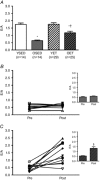
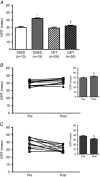
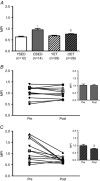
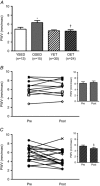
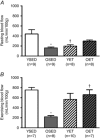


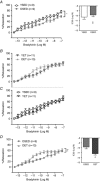
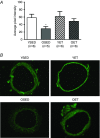
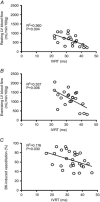
Comment in
-
Effects of exercise training on endothelial and diastolic age-related dysfunctions: a new view of an old problem.J Physiol. 2017 Jul 15;595(14):4591-4592. doi: 10.1113/JP274531. Epub 2017 Jun 4. J Physiol. 2017. PMID: 28466473 Free PMC article. No abstract available.
-
Life [ageing] is like riding a bicycle. To keep your [coronary and heart] balance you must keep moving.J Physiol. 2017 Jun 15;595(12):3701-3702. doi: 10.1113/JP274297. Epub 2017 May 14. J Physiol. 2017. PMID: 28502077 Free PMC article. No abstract available.
-
Diastolic dysfunction and older adults: heating up the conversation.J Physiol. 2017 Aug 1;595(15):5011-5012. doi: 10.1113/JP274695. Epub 2017 Jun 27. J Physiol. 2017. PMID: 28590085 Free PMC article. No abstract available.
-
Maybe the fountain of youth was actually a treadmill: role of exercise in reversing microvascular and diastolic dysfunction.J Physiol. 2017 Sep 1;595(17):5755-5756. doi: 10.1113/JP274674. Epub 2017 Jul 26. J Physiol. 2017. PMID: 28691755 Free PMC article. No abstract available.
References
-
- Abdelmoneim SS, Basu A, Bernier M, Dhoble A, Abdel‐Kader SS, Pellikka PA & Mulvagh SL (2011). Detection of myocardial microvascular disease using contrast echocardiography during adenosine stress in type 2 diabetes mellitus: prospective comparison with single‐photon emission computed tomography. Diab Vasc Dis Res 8, 254–261. - PubMed
-
- Adams V, Alves M, Fischer T, Rolim N, Werner S, Schutt N, Bowen TS, Linke A, Schuler G & Wisloff U (2015). High‐intensity interval training attenuates endothelial dysfunction in a Dahl salt‐sensitive rat model of heart failure with preserved ejection fraction. J Appl Physiol (1985) 119, 745–752. - PubMed
-
- Aeschbacher BC, Hutter D, Fuhrer J, Weidmann P, Delacretaz E & Allemann Y (2001). Diastolic dysfunction precedes myocardial hypertrophy in the development of hypertension. Am J Hypertens 14, 106–113. - PubMed
-
- Aroesty JM, Mckay RG, Heller GV, Royal HD, Als AV & Grossman W (1985). Simultaneous assessment of left‐ventricular systolic and diastolic dysfunction during pacing‐induced ischemia. Circulation 71, 889–900. - PubMed
-
- Ather S, Chan W, Bozkurt B, Aguilar D, Ramasubbu K, Zachariah AA, Wehrens XH & Deswal A (2012). Impact of noncardiac comorbidities on morbidity and mortality in a predominantly male population with heart failure and preserved versus reduced ejection fraction. J Am Coll Cardiol 59, 998–1005. - PMC - PubMed
Publication types
MeSH terms
Grants and funding
LinkOut - more resources
Full Text Sources
Other Literature Sources

